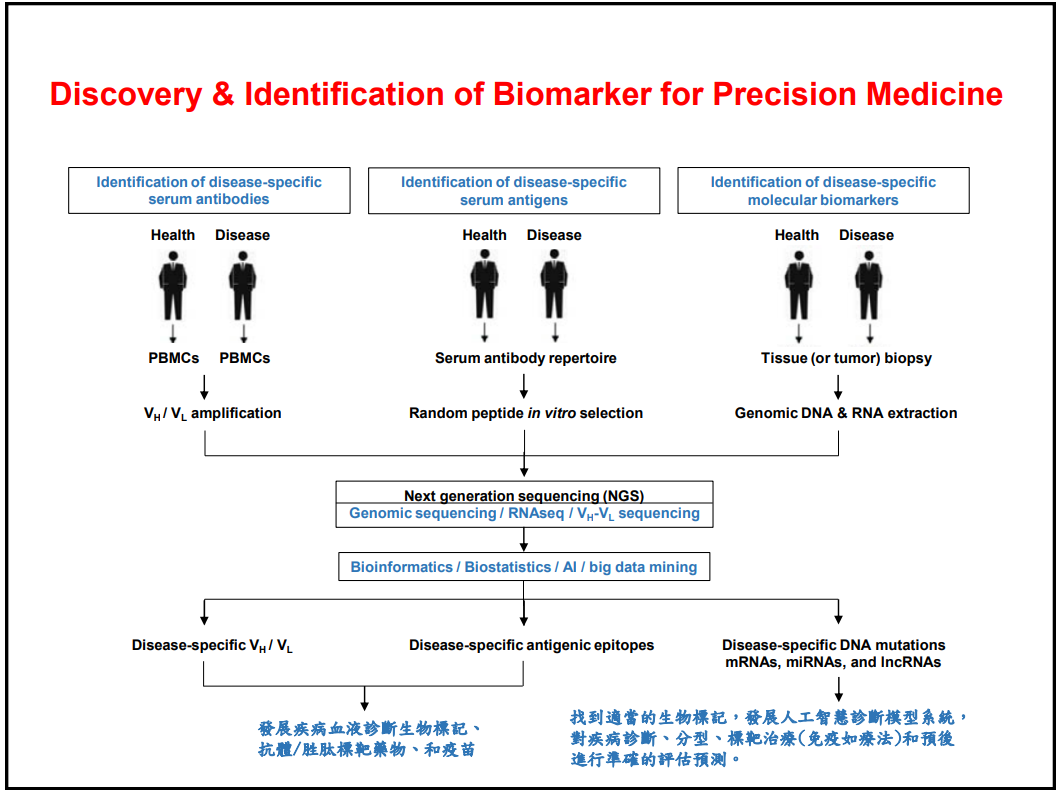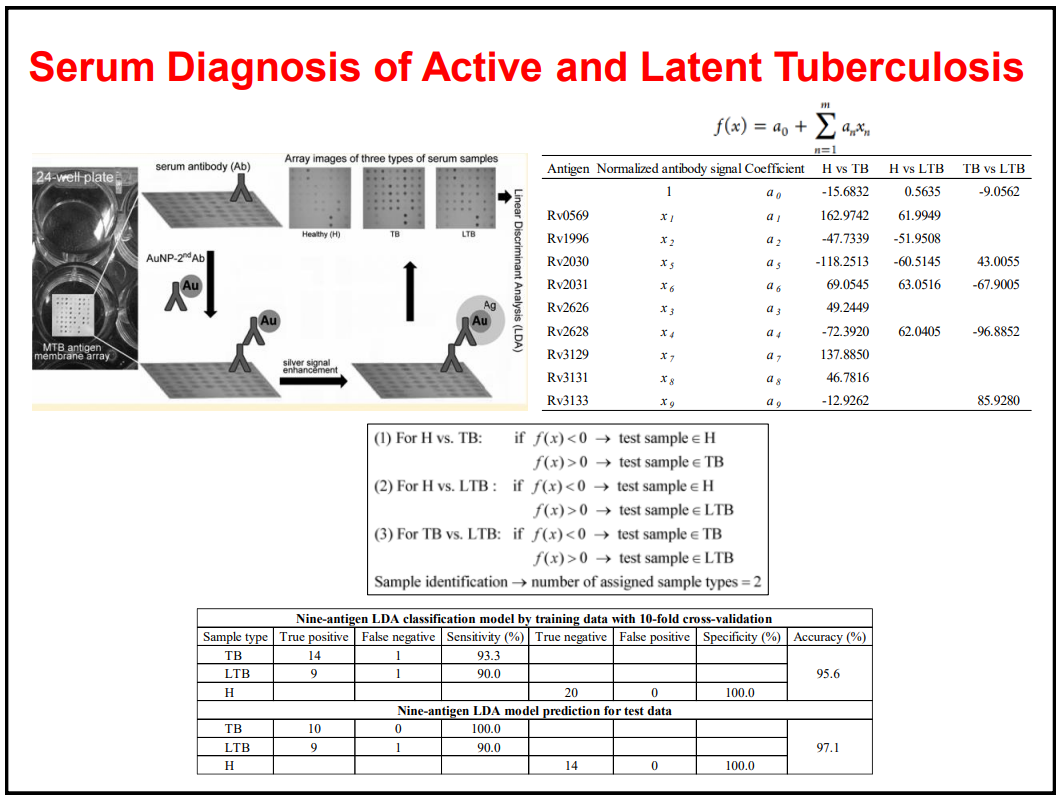Cheng-Chung Chou
CHENG-CHUNG, CHOU
Tel: (05)2720411 ext. Office 66506 Lab 61517
Fax: (05)2722871
Email: bioccc@ccu.edu.tw
Ph.D. Dept. of Chemical Engineering, Univ. of Maryland-College Park
- 103/02 - Present Associat Professor, Department of Biomedical Sciences, National Chung Cheng University
- 95/08 - 103/01 Assistant Professor, Department of Life Science, National Chung Cheng University
- Nano-biotechnology
- Molecular diagnostics
- antibody engineering
- Bioinformatics
- AI analysis for genomics, transcriptomics, and antibodiomics
本實驗室著重於跨領域的研究,充分整合分子生物與生物技術、生物統計與生物資訊、以及人工智慧三大面向探討疾病(特別是癌症)精準醫療的可能性。首先,從全球公共資料庫和自家實驗數據收集醫學影像、基因體突變、RNA表達 (mRNA和non-coding RNA)和血液抗體等定序序列、以及相關臨床醫療資訊等生醫大數據,再結合深度學習神經網路和機器學習多變量統計分析,探討是否能找到適當的生物標記,發展出人工智慧診斷模型系統,對疾病診斷、分型、標靶治療(包含免疫療法)和預後進行準確的評估預測。
目前已開發出肺結核蛋白質檢測晶片,偵測血液樣本中九個結核菌抗體,並利用機器學習演算法判別受測個體為健康、結核菌感染或潛伏性結核菌感染,上述技術已獲得中華民國專利。此外,我們也已建構出肺結核病人血液中特有抗體庫,重建結核菌感染的分子致病機轉。肺癌相關研究也已開展,篩選並鑑定出數個與肺癌細胞表面抗原特異性結合的抗體或胜肽,進而可據此發展癌症血液診斷、以及抗體或胜肽抗藥物複合體的標靶治療。最近我們提出可同時結合化學療法,免疫療法和奈米粒子藥物傳輸的腫瘤智慧型標靶療法,可增強癌症精準治療並大幅降低免疫療法引起相關的不良反應。同時,我們正發展人工智慧診斷模型系統,對腫瘤組織的基因體突變與免疫细胞浸潤、RNA-seq基因表達差異與臨床指標共表達加權網路、mRNA/miRNA/lncRNA共表達交互網路、以及相應臨床醫療資訊進行全面的統合分析,預期可篩選出有價值的生物標記,進行癌症個人化暨智慧化的精準治療。




- 周正中、曾啟偉,「基於全體基因表現及生物反應路徑以及基因本體學之反應路徑分群方法」,中華民國專利證號I468968 (2015)
- 周正中、曾啟偉,“Machine-implemented method for analyzing genome-wide gene expression profiling cross-reference to related application”,美國專利申請案號13/728291 (2012)
- 周正中等,「判別開放性或潛伏性結核菌感染之方法」,中華民國專利證號I458978 (2014)
- 范建得、羅仁權、吳明發、張益華、周正中、徐建業,「自搜尋擴充與分類修正之智慧財產權媒合系統與方法」,中華民國專利證號I346906 (2011)
- 周正中等,「可溫控之微型生物分子反應晶片」,中華民國專利證號M373489 (2010)
- Shi SD, Hsueh PR, Yang PC, Chou CC*. Use of DosR dormancy antigens from Mycobacterium tuberculosis for serodiagnosis of active and latent tuberculosis. ACS Infectious Diseases, 2020, 6 (2): 272-80. (SCI, Impact factor = 4.911, 4/61, CHEMISTRY, MEDICINAL)
- Chou CC*, Chen W, Hung Y, Mou CY. Molecular elucidation of biological response to mesoporous silica nanoparticles in vitro and in vivo. ACS Applied Materials & Interfaces, 2017, 9 (27): 22235–51. (SCI, Impact factor = 8.456, 27/293, MATERIALS SCIENCE, MULTIDISCIPLINARY)
- Chou CC*. Identification of the pivotal role of glutamate in enhancing insect cell growth using factor analysis. Cytotechnology, 2014, 66(5): 853-60. (SCI, Impact factor = 1.672, 119/162, BIOTECHNOLOGY & APPLIED MICROBIOLOGY)
- Chen PH, Hsiao KM, Chou CC*. Molecular characterization of toxicity mechanism of single-walled carbon nanotubes. Biomaterials, 2013, 34: 5661-5669. (SCI, Impact factor = 10.273, 1/32, MATERIALS SCIENCE, BIOMATERIALS)
- Chou CC*. Identification of bioactive yeastolate fractions responsible for insect cell growth and polyhedra production. Journal of Biochemical Technology, 20134 (3): 611-615.
- Chou CC*, Huang YH. Nucleic acid sandwich hybridization assay with quantum dot-induced fluorescence resonance energy transfer for pathogen detection. 2012, Sensors, 2012, 12: 16660-16672. (SCI, Impact factor = 3.031, 15/61, INSTRUMENTS & INSTRUMENTATION)
- Hsieh WY, Chou CC, Ho CC, Yu SL, Chen HY, Chou HY, Chen JJ, Chen HW, Yang PC. Single-walled carbon nanotubes induce airway hyper-reactivity and parenchymal injury in mice. American Journal of Respiratory Cell and Molecular Biology, 2012, 46: 257-267. (SCI, Impact factor = 4.340, 13/63, RESPIRATORY SYSTEM).
- Pan HC, Lin YJ, Li MW, Chuang HN, Chou CC*. Aquatic toxicity assessment of single-walled carbon nanotubes using zebrafish embryos. 2011, Journal of Physics: Conference series, 2011, 304: 012026.
- Chou CC, Hsiao HY, Hong QS, Chen CH, Peng YW, Chen HW and Yang PC. Single-walled carbon nanotubes can induce pulmonary injury in mouse model. Nano Letters, 2008, 8: 437-45. (SCI, Impact factor = 12.279, 19/293, MATERIALS SCIENCE, MULTIDISCIPLINARY).
- Chou CC and Peck K. Design and fabrication of spotted long oligonucleotide microarrays for gene expression analysis in Chapter 10 of Methods in Molecular Biology – Microarrays: Synthesis methods 2007; 381: 213-25 (book chapter)
- Sher YP, Chou CC, Chou RH, Wu HM, Chang WSW, Chen CH, Yang PC, Wu CW, Yu CL, and Peck K. Human kallikrein 8 protease confers a favorable clinical outcome in non–small cell lung cancer by suppressing tumor cell invasiveness. Cancer Research 2006, 66: 11763-70. (IF=9.122, R/C=15/217, ONCOLOGY).
- Chen HW, Su SF, Chien CT, Lin WH, Yu SL, Chou CC, Chen JW and Yang PC. Titanium dioxide nanoparticles induce emphysema-like lung injury in mice. FASEB Journal 2006, 20: E1732-412393-95. (IF=5.498, R/C=7/84, BIOLOGY, CELL BIOLOGY)
